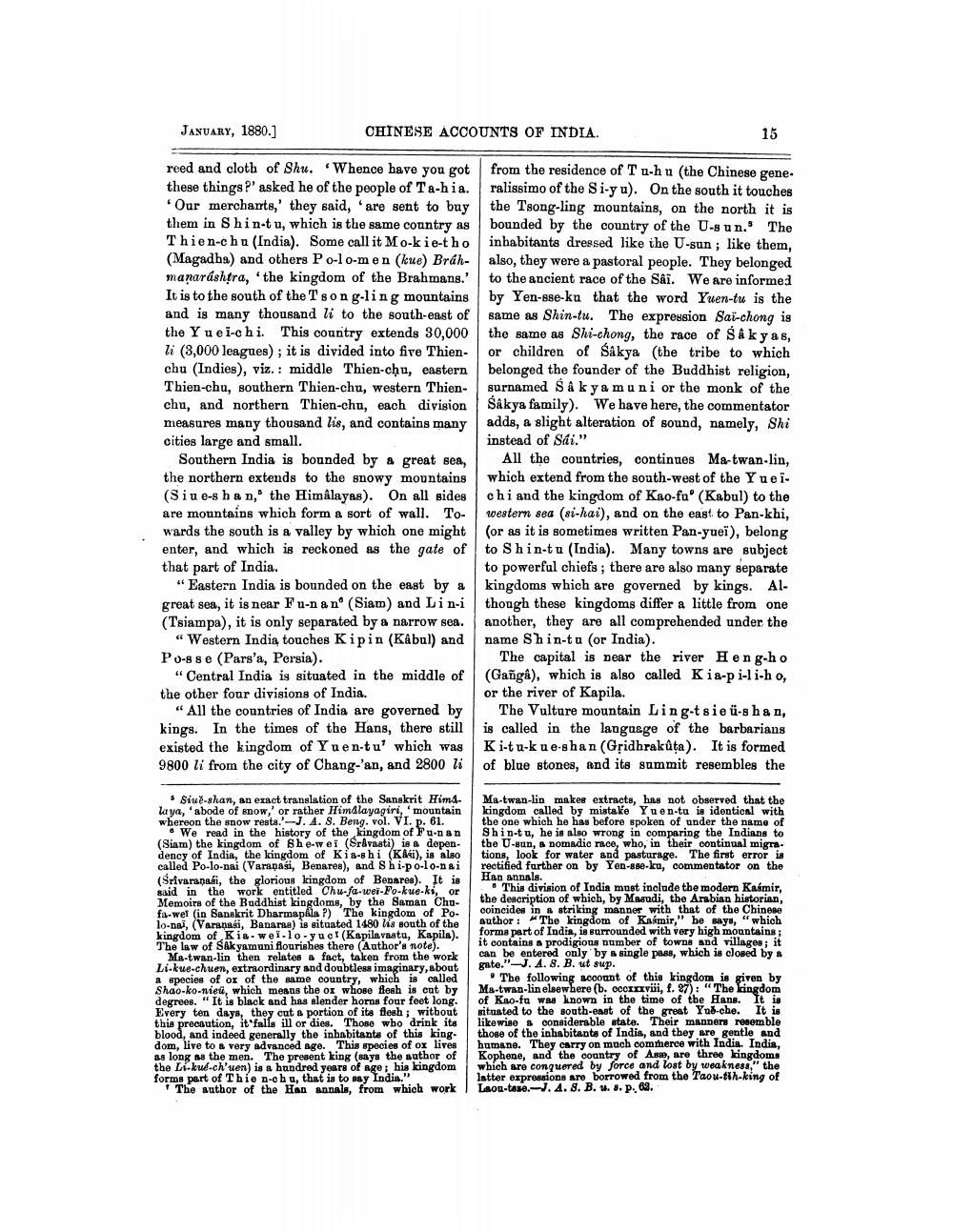________________
JANUARY, 1880.]
reed and cloth of Shu. Whence have you got these things?' asked he of the people of Ta-hia. Our merchants,' they said, 'are sent to buy them in Shin-t u, which is the same country as Thien-chu (India). Some call it Mo-kie-t ho (Magadha) and others P o-lo-men (kue) Bráhmanarashtra, the kingdom of the Brahmans.' It is to the south of the Tsong-ling mountains and is many thousand li to the south-east of the Yuei-chi. This country extends 30,000 li (3,000 leagues); it is divided into five Thienchu (Indies), viz.: middle Thien-chu, eastern Thien-chu, southern Thien-chu, western Thienchu, and northern Thien-chu, each division measures many thousand lis, and contains many cities large and small.
CHINESE ACCOUNTS OF INDIA.
Southern India is bounded by a great sea, the northern extends to the snowy mountains (Siu e-s han, the Himalayas). On all sides are mountains which form a sort of wall. Towards the south is a valley by which one might enter, and which is reckoned as the gate of that part of India.
"Eastern India is bounded on the east by a great sea, it is near Fu-n a n° (Siam) and Lin-i (Tsiampa), it is only separated by a narrow sea. "Western India touches Kipin (Kâbul) and Po-sse (Pars'a, Persia).
All the countries, continues Ma-twan-lin, which extend from the south-west of the Yue ïchi and the kingdom of Kao-fu" (Kabul) to the western sea (si-hai), and on the east to Pan-khi, (or as it is sometimes written Pan-yueï), belong to Shin-tu (India). Many towns are subject to powerful chiefs; there are also many separate kingdoms which are governed by kings. Although these kingdoms differ a little from one another, they are all comprehended under the name Shin-tu (or India).
The capital is near the river Heng-ho "Central India is situated in the middle of (Gañgâ), which is also called Kia-pi-li-ho, the other four divisions of India. or the river of Kapila.
The Vulture mountain Ling-t sie ü-shan, is called in the language of the barbarians Ki-tu-kue-shan (Gridhrakûṭa). It is formed of blue stones, and its summit resembles the
"All the countries of India are governed by kings. In the times of the Hans, there still existed the kingdom of Yuen-tu' which was 9800 li from the city of Chang-'an, and 2800 li
15
Siue-shan, an exact translation of the Sanskrit Himalaya, 'abode of snow, or rather Himalayagiri, 'mountain whereon the snow rests.'-J. A. 8. Beng. vol. VI. p. 61.
We read in the history of the kingdom of Fu-nan (Siam) the kingdom of She-wei (Srivasti) is a dependency of India, the kingdom of Kia-shi (KA), is also called Po-lo-nai (Varanasi, Benares), and Shi-po-lo-nai (Srivaranasi, the glorious kingdom of Benares). It is said in the work entitled Chu-fa-wei-Fo-kue-ki, or Memoirs of the Buddhist kingdoms, by the Saman Chufa-wel (in Sanskrit Dharmapala ?) The kingdom of Polo-nai, (Varanasi, Banaras) is situated 1480 lis south of the kingdom of Kia-wei-lo-yue! (Kapilavastu, Kapila). The law of Sakyamuni flourishes there (Author's note).
Ma-twan-lin then relates a fact, taken from the work Li-kue-chuen, extraordinary and doubtless imaginary, about a species of ox of the same country, which is called Shao-ko-nieu, which means the ox whose flesh is cut by degrees. "It is black and has slender horns four feet long. Every ten days, they cut a portion of its flesh; without this precaution, it falls ill or dies. Those who drink its blood, and indeed generally the inhabitants of this kingdom, live to a very advanced age. This species of ox lives as long as the men. The present king (says the author of the Li-kué-ch'uen) is a hundred years of age; his kingdom forms part of Thie n-chu, that is to say India."
The author of the Han annals, from which work
from the residence of T u-h u (the Chinese gene. ralissimo of the Si-y u). On the south it touches the Tsong-ling mountains, on the north it is bounded by the country of the U-sun. The inhabitants dressed like the U-sun; like them, also, they were a pastoral people. They belonged to the ancient race of the Sâï. We are informed by Yen-sse-ku that the word Yuen-tu is the same as Shin-tu. The expression Saï-chong is the same as Shi-chong, the race of Sakyas, or children of Sakya (the tribe to which belonged the founder of the Buddhist religion, surnamed Sakyamuni or the monk of the Sakya family). We have here, the commentator adds, a slight alteration of sound, namely, Shi instead of Sái."
Ma-twan-lin makes extracts, has not observed that the kingdom called by mistake Yuen-tu is identical with the one which he has before spoken of under the name of Shin-tu, he is also wrong in comparing the Indians to the U-sun, a nomadic race, who, in their continual migrations, look for water and pasturage. The first error is rectified farther on by Yen-sse-ku, commentator on the Han annals.
This division of India must include the modern Kasmir, the description of which, by Masudi, the Arabian historian, coincides in a striking manner with that of the Chinese author: The kingdom of Kasmir," he says, "which forms part of India, is surrounded with very high mountains; it contains a prodigious number of towns and villages; it can be entered only by a single pass, which is closed by a gate."-J. A. 8. B. ut sup.
The following account of this kingdom is given by Ma-twan-lin elsewhere (b. cccxxxviii, f. 27): "The kingdom of Kao-fu was known in the time of the Hans. It is situated to the south-east of the great Yub-che. It is likewise a considerable state. Their manners resemble those of the inhabitants of India, and they are gentle and humane. They carry on much commerce with India. India, Kophene, and the country of Asse, are three kingdoms which are conquered by force and lost by weakness," the latter expressions are borrowed from the Taou-tih-king of Laou-tese.-J. A. 8. B. u. s. p." 63.




